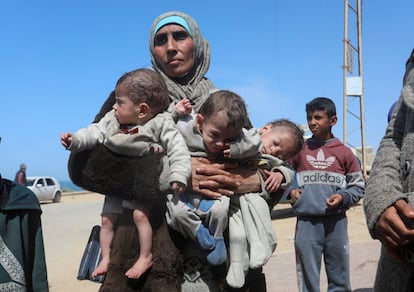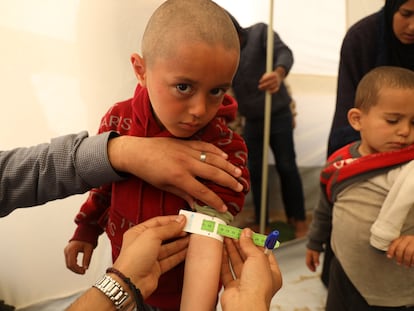US submits UN resolution calling for an ‘immediate ceasefire’ in Gaza ‘tied to the release of hostages’
Washington has vetoed all the truce proposals submitted to the Security Council so far. If the cessation of hostilities were to go ahead, it would not automatically mean an end to the war

On Thursday, U.S. Secretary of State Antony Blinken announced that his country has submitted a draft resolution to the U.N. Security Council for an “immediate ceasefire” in Gaza “tied to the release” of the 134 hostages still held by Palestinian militias in the Gaza Strip. The top U.S. diplomat has stated that the Israeli team that will travel to the United States next week — led by Defense Minister Yoav Gallant — is studying another way to eliminate Hamas without launching a major ground invasion in the Rafah area, which Prime Minister Benjamin Netanyahu now admits will take some time to begin. Meanwhile, the Israeli army puts the number of militiamen killed at 140 (50 in the last day), along with 600 arrests, in four days of raids on the Al Shifa hospital in Gaza’s capital; there has been hardly any information about those raids.
In the five and a half months of war, Washington has vetoed all of the ceasefire proposals submitted to the U.N. Security Council, where the United States has a permanent seat. The scheme that the Secretary of State is now promoting would not automatically mean an end to the conflict. Washington is not asking for that from Israel, to which the United States has been providing financing and weaponry. Instead, the U.S. is focusing its strategy on an agreement to a ceasefire for a month and a half in its first phase (six times longer than the first ceasefire in November), seeking to reduce tensions and have a domino effect: alleviating the serious humanitarian crisis in Gaza, avoiding the spread of more violence to the West Bank and calming Israel’s hot border with Lebanon, where the country exchanges fire with Hezbollah and other militias daily.
Blinken was optimistic about a second ceasefire agreement, which the parties have been negotiating in Qatar. He has described it as “very much possible” because “the gaps have narrowed” between the parties. “That would bring immediate relief to so many people who are suffering in Gaza — the children, the women, the men. It would allow a much greater expansion of humanitarian assistance getting to them, and it could create the conditions to have a lasting, enduring ceasefire, which is also what we want to see. So that’s the urgency in this moment. That’s what we’re pressing, with Qatar and Egypt working closely with us to try to get an agreement,” he said in an interview with the Arabic-language Al Arabiya network in Jeddah, Saudi Arabia. “We hope very much that countries will support that. I think that would send a strong message, a strong signal,” he added. He also considered it “imperative” that more aid enter Gaza and pointed out that it will be the main focus of his visit to Israel this Friday, which was not part of the initial agenda.
According to the draft resolution, which the U.S. delegation to the U.N. intends to put to a vote this week — not before noon this Friday, according to diplomatic sources — the Security Council “unequivocally supports international diplomatic efforts to establish an immediate and sustained ceasefire as part of a deal that releases the hostages, and that allows the basis for a more durable peace to alleviate humanitarian suffering.” The text also emphasizes that “the window of opportunity created by any ceasefire” should redouble diplomacy to establish the conditions “for a sustainable cessation of hostilities and lasting peace [as set out in resolution 2720].” Resolution 2720 addresses the protection of civilians and the provision of immediate humanitarian assistance to Palestinians in Gaza, which the Security Council adopted in December.
The U.S. draft resolution — which has taken over a month to prepare and has had six successive versions, even though its final terms do not differ greatly from the formulations in other proposed resolutions — also reiterates the call for all parties to the conflict to respect international law, including humanitarian law; and “the full, immediate, safe, sustained and unhindered delivery of humanitarian assistance at scale directly to the Palestinian civilian population throughout the Gaza Strip” in line with resolutions 2712 (on the creation of humanitarian pauses and corridors) and 2720.
The announcement comes at a time of heightened tension between the U.S. and Benjamin Netanyahu’s government, primarily over the announced invasion of Rafah and Israeli obstacles to humanitarian aid, which have made Gazans the population with the fastest deteriorating food security at an unheard-of rate anywhere in the world. Hundreds of thousands are on the brink of starvation.
Disagreement
Blinken also referred to the incursion in Rafah, which has become a touchstone in the relationship and the red line that the international community — including its closest allies — is drawing with Israel after almost half a year of war. As of Thursday, the conflict has caused nearly 32,000 deaths, as well as scenes of malnutrition, battles over food and the destruction of entire neighborhoods. “What we don’t want to see is a major ground operation because we don’t see how that can be done without doing terrible harm to civilians. But at the same time, it is imperative to do something about Hamas, because Hamas has brought nothing but death and destruction to Palestinians,” he said.
On Wednesday, Netanyahu addressed the issue in a statement about a conversation he had two days earlier with U.S. President Joe Biden, their first talk in a month. “I told him: It is impossible to complete the victory without the IDF entering Rafah in order to eliminate the remnants of Hamas’s battalions. [...] There have been times when we have agreed with our friends, and there have been times when we have not agreed with them. In the end, we have always done what is vital for our security, and this is what we will do this time as well,” he said, recalling that he has already approved the operational plans for the incursion and will do so soon with those for the “evacuation” — i.e., the forced displacement — of the 1.4 million Gazans displaced there, mainly because of his order at the beginning of the war that they vacate the north and head south. The incursion itself will still take some time, he said.
The word “alternative” is increasingly being used in conjunction with the word Rafah. According to the Pentagon, in a telephone conversation U.S. Secretary of Defense Lloyd Austin expressed to the Israeli Defense Minister “the need to consider alternatives to a major ground operation in Rafah.”
Meanwhile, Israel has increased the number of militiamen it has killed to 140 (50 in the last day), along with 600 arrests in its Monday raid on the Al Shifa hospital, a large compound in the capital where Israel has positioned armored vehicles and sharpshooters. Israel claims that members of Hamas were hiding in Gaza’s largest medical center, which is now home to thousands of displaced people, patients and medical staff, while Hamas claims that it is fighting in the surrounding area. Two Israeli soldiers were killed in the clashes. The operation in Al Shifa “surprised the terrorists… half a year ago [it] took us a month to reach [Shifa]; now we did it in a flash,” the Israeli defense minister boasted on Thursday.
Sign up for our weekly newsletter to get more English-language news coverage from EL PAÍS USA Edition
Tu suscripción se está usando en otro dispositivo
¿Quieres añadir otro usuario a tu suscripción?
Si continúas leyendo en este dispositivo, no se podrá leer en el otro.
FlechaTu suscripción se está usando en otro dispositivo y solo puedes acceder a EL PAÍS desde un dispositivo a la vez.
Si quieres compartir tu cuenta, cambia tu suscripción a la modalidad Premium, así podrás añadir otro usuario. Cada uno accederá con su propia cuenta de email, lo que os permitirá personalizar vuestra experiencia en EL PAÍS.
¿Tienes una suscripción de empresa? Accede aquí para contratar más cuentas.
En el caso de no saber quién está usando tu cuenta, te recomendamos cambiar tu contraseña aquí.
Si decides continuar compartiendo tu cuenta, este mensaje se mostrará en tu dispositivo y en el de la otra persona que está usando tu cuenta de forma indefinida, afectando a tu experiencia de lectura. Puedes consultar aquí los términos y condiciones de la suscripción digital.
More information
Archived In
Últimas noticias
Venezuela breaks energy agreements with Trinidad and Tobago due to alleged complicity with the US
The murder of Michele and Rob Reiner: A tale of horrific days in Hollywood
Trump orders a ‘complete blockade of sanctioned oil tankers’ going to and from Venezuela
Not all insomnia is the same: Study identifies five subtypes and paves the way for personalized treatment
Most viewed
- ‘El Limones’ and the growing union disguise of Mexican organized crime
- Christian Louboutin: ‘Young people don’t want to be like their parents. And if their parents wear sneakers, they’re going to look for something else’
- ‘We are dying’: Cuba sinks into a health crisis amid medicine shortages and misdiagnosis
- A mountaineer, accused of manslaughter for the death of his partner during a climb: He silenced his phone and refused a helicopter rescue
- The low-cost creative revolution: How technology is making art accessible to everyone










































